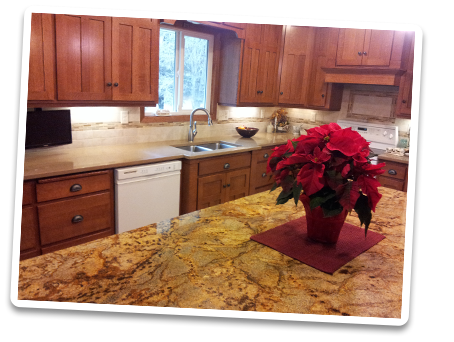Granite

Granite Information & Care Instructions
Cleaning
Normal cleaning is accomplished with simple soap and water or any common non-abrasive household cleaner. Cleaners specific for natural stone are available from custom Stone Interiors. We do not recommend using any thing regularly that contains vinegar, ammonia, bleaches, or wax. The product should be pH neutral. For stronger cleaning, a mild solution of vinegar and water can be used although repeated applications the vinegar remove the sealer.
Sealing
Natural stone is a porous material. A sealer that is FDA approved for food preparation surfaces is applied to your stone as the final step in the fabrication process.
It is recommended this sealer be reapplied approximately once per year although many stones may actually require sealing less frequently or not at all. Sealing is as simple as wiping the sealer on to the stone surface, waiting a few minutes per the instructions on the bottle, and then wiping the excess away with a clean, dry, absorbent rag. Sealer is available from Custom Stone Interiors.
Heat
Granite is virtually impervious to the temperatures in your kitchen; even a red-hot pan hot off the stove will not harm the stone. If something in your kitchen is hot enough to damage your natural stone countertop your house is on fire!
Staining & Stain Removal
The sealer applied to natural stone by the fabricator is usually very effective in protecting the stone from staining. Staining of a natural stone countertop is a very infrequent event; in approximately 2000 jobs we have had customers with a stain issue only twice. Stains that do occur are normally the result of an oil or acidic spill (such as bacon grease, wine or fruit juice) which is left on the stone surface for a period of time.
Because stone has been used for interior applications for thousands of years, a large body of knowledge exists regarding the materials and procedures for removing stains. In the unlikely event your granite becomes stained CSI can provide the directions which detail the steps which are usually successful in removing a stain from natural stone. Most important is accurate identification of the stain prior to beginning the stain removal process.
Bacterial Contamination
Sealed natural stone is highly resistant to bacterial contamination. A formal study of bacterial contamination on typical countertop surfaces cleaned with dish soap produced the results detailed in the following.
As you can see from the data below granite responds very well to mild disinfectant. It was the only material in the study that was within a factor of 100 of stainless steel after disinfecting.
For the laminate, washing and rinsing reduced the bacterial counts by about 285. When the vinegar was applied, the overall reduction was increased to about 500,000 to 1.
For the wood, washing and rinsing reduced the bacterial counts by about 500. When the vinegar was applied, the overall reduction was increased to about 2,000 to 1.
For the tile, washing and rinsing reduced the bacterial counts by about 900 to 1. When the vinegar was applied, the overall reduction was increased to about 233,000 to 1.
For the concrete, washing and rinsing reduced the bacterial counts by about 2,400 to 1. When the vinegar was applied, the overall reduction was increased to about 30,600 to 1.
For the stainless steel, washing and rinsing reduced the bacterial counts by about 4,000 to 1. When the vinegar was applied, the overall reduction was increased to about 230,000,000 to 1.
For the granite, washing and rinsing reduced the bacterial counts by about 36,000 to 1. When the vinegar was applied, the overall reduction was increased to about 80,000,000 to 1. The complete study is available at: http://www.hi-tm.com/Documents/Countertops.html
Scratch Removal
Scratches in granite in the home are unlikely as the granite is harder than most other materials typically found in the home with the exception of diamond jewelry. (Specific watch outs are stone planters and the green “ScotchBrite” pads.) Marble and travertine are softer and can be scratched (which is why they are considered less suitable for high usage areas like the kitchen.) Scratch removal is often possible but requires the tools and expertise of a professional stone worker.
Chips
On occasion granite, marble, or travertine surfaces or edges can be chipped by an accidental impact from a heavy object like a cast iron cooking utensil or fireplace implement. Granite fabricators have adhesives and fillers to repair such damage. In most cases the repaired area is indistinguishable from the rest of the stone. Chipping is very uncommon and overall stone surfaces are far more resistant to damage than any of the alternative materials.






